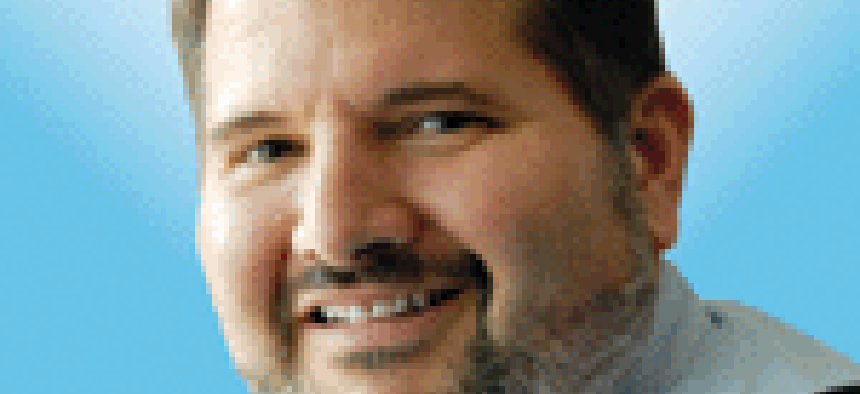Retirement not in Jay Nussbaum's vocabulary

Former Agilex executive Jay Nussbaum isn't sitting still after selling the company he co-founded; instead, he's leading two companies, and says he's busier than ever.
After selling Agilex to Accenture in 2015, Jay Nussbaum could have easily sat back and enjoyed a retirement filled with golf, board duties and the occasional consulting gig.
But that got old after about two months. Plus, his fiancée, Susan Hemme, had co-founded a health care company, Topline Healthcare, with a very promising software solution. And then there was a small drone company in Jacksonville, Fla., Drone Aviation Corp. that needed more than just his presence on its board.
Nussbaum, who co-founded Agilex with the late Bob LaRose, quickly went from zero to 60, becoming chairman and CEO of Drone Aviation and chairman and co-partner of Topline.
“I’m busier now than I was at Agilex,” he said. Prior to Agilex, Nussbaum had stints in executive positions at Xerox, BearingPoint and Oracle.
Topline and Drone Aviation touch similar passions in Nussbaum – innovative technologies that address critical mission needs.
I’ll start with Topline.
Hemme, who is now Nussbaum’s wife, co-founded the company with Mark Kimmel, who took his two decades as a healthcare professional and applied them to software development, creating what is known as Codeable Language. The software is a powerful tool that helps health care providers document their procedures and interactions with patients.
The goal is to help hospitals and health care providers improve reimbursement rates. The Centers for Medicaid and Medicare rejects millions of filings for reimbursement each year because they are incorrectly coded. “Then I talked to hospitals and learned that they are writing off $10 million to $100 million in a given year because of reimbursement problems,” Nussbaum said.
“If we could address that problem, we’d really have something,” he said.
The complexity of the reimbursement issue is growing as the number of International Classification of Diseases codes, or ICDs, are expected to grow from about 14,000 to 140,000. The codes are used to classify diseases and gets very granular so there are codes for symptoms, complaints, causes of the disease or injury.
Topline has partnered with the Adobe with its Active Forms product and Infor (the ERP company that acquired Lawson Software) with its billing solutions to develop and market and offering known as H3 Solutions, to manage and integrate data collection and use. The offering also is cloud-based.
CMS has approved the use of the Codeable Language, which is like getting the Good Housekeeping seal of approval, he said. Hospitals can actually get reimbursed for installing the product.
With the release of H3 in October, Topline also is looking beyond CMS.
“Now we have the chance to go into Veterans Affairs and help them with billing and open up the use of community hospitals,” Nussbaum said.
If the offering moves into the Defense Health Agency, it also could aid in making medical records between DHA and VA more interoperable.
Another advantage of the partnership with Adobe and Infor is that Topline doesn’t need to create and manage a sales force. It can continue to focus on honing its product and working directly with customers, Nussbaum said.
“We’re leveraging the sales force that Adobe and Infor already have in place,” he said.
They also are looking to partner with systems integrators in the healthcare space such as Accenture, which acquired Agilex.
“This is a different spin on selling and I love it,” he said.
Now for Nussbaum’s second company – Drone Aviation, headquartered in Jacksonville, Fla. – Nussbaum had been on the board for several months when he was tapped as chairman, and then in May, he was named CEO.
“This is a really unique technology, and it is a market that is just at its beginning,” he said.
Drone Aviation’s drones are tethered, which means they can stay up almost constantly because the power source is on the ground and the tether provides a secure data link back to the ground as well, Nussbaum said.
“We don’t sell it as a drone, but as an information machine,” he said. “Obviously there is a huge market in the military.”
Special operations customers have been early adopters, but Nussbaum said he couldn’t go into details other than to say the company’s drones have been used in Africa and the Middle East. The Homeland Security Department also is a target market.
The uses of the tethered drones include surveillance, force protection, crowd management, border protection and infrastructure inspections.
One model can continue to fly even if the vehicle it is tethered to is moving at 45 miles per hour, Nussbaum said.
But he emphasized that the use as an information platform is what makes the company’s approach unique. The drones are flying sensors transmitting imagery and can even be equipped with night vision.
The railroad CSX did a security project over one of its rail yards and caught thieves breaking into rail cars, Nussbaum said.
Monitoring seaports is another application, especially when you consider the high cost of using manned helicopters, he said.
Drone Aviation is already publicly traded as an over the counter stock. Its symbol is DRNE. Nussbaum’s expectation is that once the company gets to a certain level of success, it will be acquired. “That’s the game plan,” he said. That should take two or three years.
With Topline being a software company, Nussbaum said he doesn’t see the need to be acquired to continue its growth. It has about $600,000 in revenue after just one year in business.
“That’s not bad and we have lots of accounts on the horizon,” he said. It could remain an independent company for many years to come.
So, Nussbaum expects to be busy for quite some time; “besides, my golf game is terrible.”
